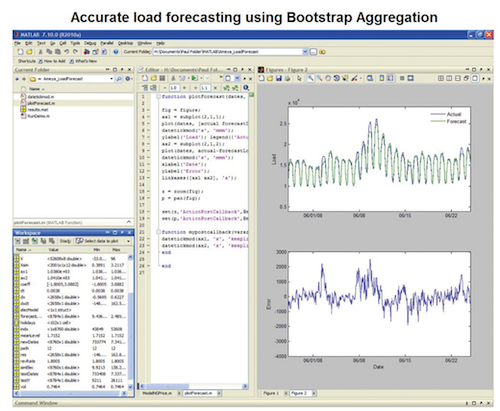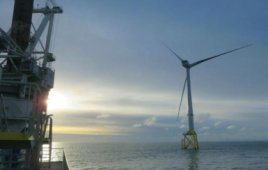Paul Pilotte
Technical marketing
Manager
Mathworks
Natick, mass.
www.mathworks.com
Managing a wind-farm portfolio is a promising renewable energy business, but operators face risks and challenges. Wind farm operators selling power to wholesale electricity markets are looking for ways to maximize profits and reduce revenue uncertainty. To do so, they need software tools to analyze historical data, forecast prices, and determine demand on day-ahead and real-time spot markets. They must also analyze and forecast difficult-to-predict wind and weather patterns.
In a market geared towards predictable fossil fuel-based generation, software modeling tools offers a solution for better management of the inherent risks and financial uncertainty in wind portfolios.

The workflow for energy pricing and production forecasting has three main phases: access, research and quantify, and then sharing results.
Wind price and generation forecasting have two key components: the amount of energy wind produces and the energy-market price for each available time frame. These often require numerous forecast points along with software that can quickly perform multiple numerical simulations, and is flexible enough to let a wind-farm operator customize algorithms based on wind assets.
The workflow for energy pricing and production forecasting has three main phases: access, research and quantify (sometimes called explore and discover), and share. Software such as MATLAB supports this workflow by combining a powerful numeric engine and technical programming environment with interactive modeling, visualization, and deployment tools. First, the relevant data sources for the forecasting model are accessed from historical databases, turbine-energy output files, and data feeds. Second, data analysis and visualization tools help operators understand how wind-energy production varies by location, weather conditions, time of day, and time of year. Analysts uncover key relationships and choose a best statistical model. Third, results are shared via reports and custom applications.
In the middle, or exploration and discovery phase, various statistical tools accurately estimate the energy produced per wind turbine. Common choices include autoregressive models and neural networks. Similar models can forecast system load, market price, and projected revenue. An important consideration in a forecasting environment is the ability to take one or more off-the-shelf statistical models, quickly implement and test them against historical data, and validate them against other models.
The choice of one method over another depends on several factors specific to the model, such as the amount of data available and model behavior. A common approach tries multiple statistical methods and “backtests” them. This is done by using a portion of historical data to predict other known historical values.

An example of load forecasting uses an algorithm called bootstrap aggregation, meaning it “learns” from the information provided.
For instance, consider an analysis called bootstrap aggregation, a type of ensemble learning. The example in the illustration above was trained with three years of historical data from ISO New England including the system load, temperature, and dew point. The model accurately captures the relationship between the system load and weather, day of the week, hour of the day, and holidays to produce next-day forecasts accurate to within 3% of the observed load.
The third phase in the workflow calls for sharing results. This can include publishing reports as documents or on the Web, deploying forecasting applications, or integrating algorithms into production systems. Automating manual steps in this phase can reduce errors and free up analysts for strategy and decision-making activities.
Risk analysis, another important tool, lets wind-farm operators better manage the price and volume volatility of wind generation portfolios and minimize the financial risk this volatility represents to the enterprise, customers, and shareholders. Weather variations cause volume volatility, and the potential of negative prices and tariffs for under-delivery. Over-delivery contributes to price volatilities. Risk-analysis estimates the variation in wind-farm revenue using statistical distributions fit to wind data, weather, and electricity price. Results can be used to manage exposure to these volatilities through hedging and other risk-management processes.
Wind farm operators can choose from several different software modeling and forecasting approaches. These include informal spreadsheets such as those created in Excel, turnkey trading and risk-management systems, and technical computing languages and environments such as MATLAB. Wind production and price forecasting can be automated using software that lets operators apply their experience and insights. Analysts can enhance accuracy by prototyping statistical modeling methods, quickly adapting models in response to changing needs or regulations, and sharing applications with other analysts and operations managers.
Wind power and energy trading forecasting tools are essential for wind-farm operators, but these same modeling and forecasting tools can also be used extensively by other organizations in the energy market, including other electricity producers, electric utilities, power marketers, and regional transmission organizations.
WPE
Filed Under: Software






We are looking for complated software which can provide us day ahed power forecasting in 15 Minute time block for day means 15 X 24 Hrs = 96 Reading on best accurate level limit is + – 30% , based on weather forecasting let say X , next day live data access from wind farm operator / OEM from site to Comany / remote location , Daviation from forecast power Vs live data , Auto rescheduling facitily to state electricity utility . There are 8 revision allowed. Watherfore cast facility should be available in software or can discuss , from daviation study online further option on which reasion is profit making for todays forcasting auto indicator. there are five zone i.e 70% & 100& 130% & > 150% , > 150 % . With this there is Grid frequency based tariff ie form 50.3 Hz is zero level to 47.5 for every 0.02 Hz there is UI charges i.e paise 0.12 paise for every .02 Hz
Give me your reply as soon as possible . Thanks Prerak Gandhi 91-9909986749 ( INDIA )